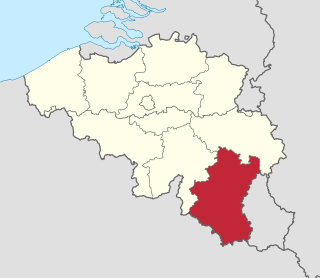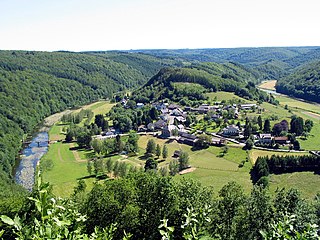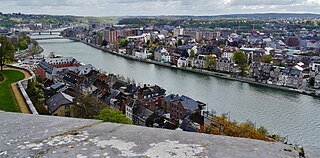Ardennes , a region of forested hills between Belgium, Luxembourg, Germany, France. Ardennes or Ardenne, or variation, may refer to:
Ardennes , a region of forested hills between Belgium, Luxembourg, Germany, France. Ardennes or Ardenne, or variation, may refer to:

Luxembourg, also called Belgian Luxembourg, is the southernmost province of Wallonia and of Belgium. It borders on the country of Luxembourg to the east, the French departments of Ardennes, Meuse and Meurthe-et-Moselle to the south and southwest, and the Walloon provinces of Namur and Liège to the north. Its capital and largest city is Arlon, in the south-east of the province.

Ardennes is a department in the Grand Est region of northeastern France named after the broader Ardennes. Its prefecture is the town Charleville-Mézières. The department has 270,582 inhabitants. The inhabitants of the department are known as Ardennais or Ardennaises.

Champagne-Ardenne is a former administrative region of France, located in the northeast of the country, bordering Belgium. Mostly corresponding to the historic province of Champagne, the region is known for its sparkling white wine of the same name.

The Ardennes, also known as the Ardennes Forest or Forest of Ardennes, is a region of extensive forests, rough terrain, rolling hills and ridges primarily in Belgium and Luxembourg, extending into Germany and France. Geologically, the range is a western extension of the Eifel; both were raised during the Givetian age of the Devonian, as were several other named ranges of the same greater range.

Namur is a city and municipality in Wallonia, Belgium. It is both the capital of the province of Namur and of Wallonia, hosting the Parliament of Wallonia, the Government of Wallonia and its administration.

Arlon is a city and municipality of Wallonia located in and capital of the province of Luxembourg in the Ardennes, Belgium. With a population of just over 28,000, it is the smallest provincial capital in Belgium. Arlon is also the capital of its cultural region: the Arelerland.

Bastogne is a city and municipality of Wallonia located in the province of Luxembourg in the Ardennes, Belgium.

The Battle of the Ardennes took place during the First World War fought on the frontiers of France, Germany, Belgium and Luxembourg from 21 to 23 August 1914. The German armies defeated the French and forced their retreat. The battle was part of the larger Battle of the Frontiers, the first battle of the Western Front.
Vaux may refer to:
Sigfried was Count in the Ardennes, and is known in European historiography as founder and first ruler of the Castle of Luxembourg in 963 AD, and ancestor and predecessor of the future counts and dukes of Luxembourg. He was also an advocate of the abbeys of St. Maximin in Trier and Saint Willibrord in Echternach.

The Duchy of Luxemburg was a state of the Holy Roman Empire, the ancestral homeland of the noble House of Luxembourg. The House of Luxembourg, now Duke of Limburg, became one of the most important political forces in the 14th century, competing against the House of Habsburg for supremacy in Central Europe. They would be the heirs to the Přemyslid dynasty in the Kingdom of Bohemia, succeeding the Kingdom of Hungary and contributing four Holy Roman Emperors until their own line of male heirs came to an end and the House of Habsburg got the pieces that the two Houses had originally agreed upon in the Treaty of Brünn in 1364.

Henri-Chapelle American Cemetery and Memorial is a Second World War American military war grave cemetery in eastern Belgium. It is 3 km (2 mi) northwest of Henri-Chapelle, about 30 km (20 mi) east of Liège. Dedicated in 1960, the cemetery contains 7,992 American war dead and covers 57 acres (23 ha).

Ardenne Castle, or the Royal Castle of Ardenne was situated in Wallonia in the municipality of Houyet in Belgium not far from Ciergnon Castle and 15 kilometres (9.3 mi) from Dinant, was a royal castle that served as a luxury hotel from 1891 to 1949. It burned down in 1969.
The Lorraine campaign was the operations of the U.S. Third Army in Lorraine during World War II from September 1 through December 18, 1944. Official U.S. Army campaign names for this period and location are Northern France and Rhineland. The term was popularized by the publication of the volume The Lorraine Campaign of the official history of the U.S. Army in 1950.

Asfeld is a commune in the Ardennes department in the Grand Est region of north-eastern France, formerly named Ecry or Ecri.
Haslach is a German word derived from Old High German hasala ("hazel") and aha. It may refer to:

Grand Est is an administrative region in Northeastern France. It superseded three former administrative regions, Alsace, Champagne-Ardenne and Lorraine, on 1 January 2016 under the provisional name of Alsace-Champagne-Ardenne-Lorraine, as a result of territorial reform which had been passed by the French Parliament in 2014.

Liberation Route Europe is an international remembrance trail that connects the main regions along the advance of the Western Allied Forces toward the liberation of Europe and final stage of the Second World War. The route started in 2008 as a Dutch regional initiative in the Arnhem-Nijmegen area and then developed into a transnational route that was officially inaugurated in Arromanches on June 6, 2014, during the Normandy D-day commemorations. The route goes from Southern England through France, Belgium, Luxembourg, the Netherlands to Berlin in Germany, then extends to the Czech Republic and Poland. The southern route starts in Italy. As a form of remembrance tourism, LRE aims to unfold these Allied offensives of 1944 and 1945 in one narrative combining the different perspectives and points of view. By combining locations with personal stories of people who fought and suffered there, it gives visitors the opportunity to follow the Allied march and visit significant sites from war cemeteries to museums and monuments but also events and commemorations. In April 2019, Liberation Route Europe became a certified Cultural Route of the Council of Europe.

TER Grand Est or TER Fluo is the regional rail network serving the region of Grand Est, northeastern France. It is operated by the French national railway company SNCF. It was formed in 2016 from the previous TER networks TER Alsace, TER Lorraine and TER Champagne-Ardenne, when the respective regions were merged.